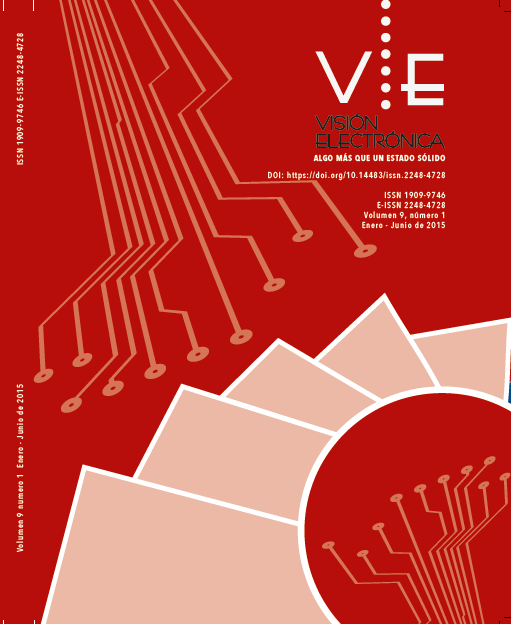DOI:
https://doi.org/10.14483/22484728.11011Publicado:
2015-06-23Número:
Vol. 9 Núm. 1 (2015)Sección:
Visión InvestigadoraLa teoría evolutiva como solución al control de formación
Evolutionary theory as solution to the formation control
Palabras clave:
control de formación, robótica móvil, sistemas multi-agente (es).Palabras clave:
formation control, mobil robotics, multiagent systems (en).Descargas
Resumen (es)
Se presenta un control de formación para múltiples Vehículos
Submarinos Autónomos con estructura de tipo líder-seguidor. El controlador se modela como un sistema multi-agente representado por un dígrafo compuesto por vértices y artistas que simbolizan los agentes (vehículos) y el sistema de comunicación, respectivamente. Se empleó la matriz Laplaciana compleja del dígrafo, para calcular la formación geométrica y enseguida se evalúa la respuesta de consenso de la formación utilizando la teoría evolutiva dinámica del replicador mutador. Finalmente, se integran las dos respuestas y se calcula la posición de cada agente seguidor. Las simulaciones muestran que combinando estas dos teorías se puede garantizar una perfecta formación geométrica en todo momento y que se pueden emplear un sinnúmero de agentes en la estructura.
Resumen (en)
We present a formation control for multiple vehicles Autonomous
submarines with type structure leader - follower. The controller is modeled as a multi-agent system represented by a digraph consisting of vertices and artists symbolizing agents (vehicles) and the communication system, respectively. The digraph complex Laplacian matrix was used to calculate the geometrical formation and then evaluates the response of the formation consensus using the dynamic evolutionary theory of the Replicator-mutator. Finally, two answers are integrated and it calculates the position of each follower agent. Simulations show that combining these two theories can be guaranteed a perfect geometrical formation at all times and that a number of agents can be used in the structure.
Referencias
X. Xiang, G. Xu, Q. Zhang, Z. Xiao and X. Huang, “Coordinated Control for Multi- AUV System Based on Hybrid Automata". Proceeding of the 2007 IEEE International conference on Robotics and Biomimetics, December 15-18, 2007.
E. Fiorelli, N.E. Leonard, P. Bhatta, D. Paley, R. Bachmayer and D.M. Fratantoni, “Multi-AUV Control and Adaptive sampling in Monterrey Bay” Oceanic Engineering, IEEE Journal of, vol.31, no. 4, pp. 935-948, 2006.
L. Paull S.G. Saeedi, M. Seto and H. Li, “A Multi-agent Framework with MOOSIvP for Autonomous Underwater Vehicles with Sidescan Sonar Sensors” M. AIS 2011, LNAI 6752, pp. 41-50, 2011
D. Floroian and F. Moldoveanu, “Using robosmith for multiagent robotic system”. Bulletin of the Transilvania University of Brasov, vol. 13, no 52, pp. 227-236, 2010.
Y. Xu, L. Wang, G. Xia and J. Xie, “System modeling and simulation research for excavation of earth- rock work based on the Theory of Multi-Agent”. First International Workshop on Education Technology and Computer Science, 2009. ETCS'09. First International Workshop on. vol 1, pp. 257-261, 2009.
S. Sen, “Multiagent systems: milestones and new horizons”. Trends in Cognitive Sciences vol 1, no 9, pp. 334-340, dec, 1997.
Q. Wu, D. Xue and J. Yao, “Consensus analysis of networked multi-agent systems” Physics Procedia, vol 3, pp.1921-1931, 2010
K. Watanabe, A. and Nakamura, “A design of tiny basin test-bed for AUV Mutli Agent” Oceans, Proceedings of MTS/IEEE, pp. 1002-1008, Sep 2005.
K. Watanabe, “Design and fabrication of a small test-bed aimed for basin experiment of underwater multi-agent system”. Symposium Underwater technology and workshop on scientific use of submarine cables and related technologies, IEEE pp. 574-580, apr 2007.
M. Wooldridge and N.R. Jennings, “Intelligent agents: theory and practice". The Knowledge Enginerring Review, vol. 10, no 2, pp. 115-152, 1995.
V.R. Lesser,”Cooperative Multiagent Systems: a personal view of the state of the art". IEEE Transactions on Knowledge and Data Engineering, vol. 11, no. 1, January/February, 1999.
M. Evans and J. Anderson “Constraint-directed intelligent control in multi-agent problem solving”. AI, Simulation and Planning in High Autonomy systems, 1990.
W.C. Regli, I. Mayk, C.J. Dugan, J.B. Kopena, R.N. Lass, J. Modi, J.K. Salvage and E.A. Sultanik, “Development and specification of a reference model for Agent-based systems", IEEE Transactions on systems, man and Cybernetics. Part C. Applications and Reviews, vol. 39, no. 5, sept, 2009.
M.N. Huhns and L.M. Stephens, “2 Multiagent systems and societies of agents". 1999.
W. Yu, G. Chen, M. Cao, “Distributed leader-follower flocking control for multi-agent dynamical systems with time-varying velocities”. Systems & Control Letters, vol 59, no. 9, pp. 543-552, sept, 2010.
X. Xiang, B. Jouvencel and O. Parodi, “Coordinated Formation Control of Multiple Autonomous Underwater Vehicles for Pipeline Inspection”. International Journal of Advanced Robotic Systems, vol. 7, no. 1, pp. 75-84, mar, 2010.
D.B. Edwards, T.A. Bean, D.L. Odell and M.J. Anderson, “A Leader– Follower Algorithm for Multiple AUV Formations”. IEEE/OES, Autonomous Underwater Vehicles, vol. 1, pp. 1-6, 2004.
P. Taylor and L. Jonker, “Evolutionary stable strategies and game dynamics”. Mathematical Biosciences, vol. 40, no. 1-2, pp.145-156, jul, 1978.
K. Page and M. Nowak, “Unifying evolutionary dynamics”. Journal of Theoretical Biology, vol. 219, no. 1, pp.. 93-98, nov, 2002.
D. Pais, and N. Leonard, “Limit cycles in replicator-mutator network dynamics”. IEEE Conference on Decision and Control and European Control Conference (CDC-ECC), pp. 3922-3927, 2011


.png)




.jpg)





